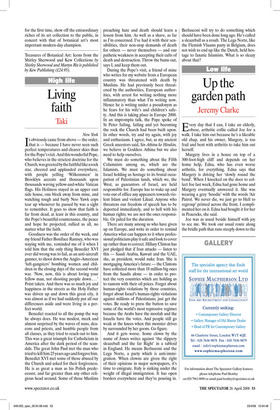Art in Kew
Ursula Buchan
In the 19th century, the painting of flowers was mainly the preserve of maiden ladies with too much time on their hands, whose watercolours would be framed by indulgent brothers, and hung on bedroom walls. Scientific botanical painting was left to talented, poorly paid artists, whose work was reproduced in Curtis’s Botanical Magazine and other learned journals, or hidden in the fastnesses of botanic gardens, where it was studied by scientists in search of answers to plant taxonomic questions. Despite the rise in its status and visibility in recent years, even now there are people who believe that botanical art is an oxymoron; that the requirements for scientific accuracy inevitably undermine, even remove, the opportunities for artistic expression.
Anyone who wants to be reassured that this view is nonsense should make a trip to see the inaugural exhibition (until 19 October) at the new £3-million Shirley Sherwood Gallery of Botanical Art in the Royal Botanic Gardens at Kew. This gallery is named after, and part-funded by, Dr Sherwood, erstwhile Oxford botanist and wife of the chairman of Orient-Express Hotels who, in less than 20 years, has built up a 700-strong collection of mainly watercolours by more than 200 contemporary flower painters and scientific artists, from all over the world. She must take at least some of the credit for what she calls ‘the renaissance’ that has occurred in botanical painting. In this gallery, the first anywhere to be given over entirely to this kind of art, a selection of her pictures will share the walls with some of the 200,000 drawings, paintings and prints which Kew possesses in its archives. The pictures displayed will be changed several times a year. Future themes include trees, and the art of plant evolution.
Botanical art, as opposed to more impressionistic flower painting, is painstaking ly accurate, usually showing the parts of a plant and the stages of its development: seed, bud, flower, fruit, leaf, root, bulb. Yet the composition of those features can elevate its execution above mere accomplished draughtsmanship. Consider, for example, Bryan Poole’s hand-coloured copperplate etching of a fern frond — the way it arcs, shielding a frond still curled up in ‘crozier’ form — or his Tecomanthe speciosa, which shows flowers on a branch enclosed by a curling tendril, as well as successive stages in the life of a flower bud, appearing to fall like raindrops down the paper. Susan Ogilvy’s ‘cherries’ are like round red notes on an imaginary stave, while Pandora Sellars’s Glory lily seems blown by a warm tropical wind.
These are works by living artists but there is artistry also in the disposition of the leaves and flowers of the Stewartia malacodendron by Georg Dionysius Ehret (1708–1770), or the bold, true colour of Francis Bauer’s bird of paradise plant, Strelitzia augusta. The seemingly careless arrangement of the many polyanthus, cowslips and primroses in Maria Sibylla Merian’s painting, dating from the late 17th century, is as carefully wrought as the corrugated leaves in the central clump. (What is so remarkable about these early artists is that they worked with no more sophisticated optical aid than a hand lens.) It is not easy to escape the conclusion that Nature herself is the greatest artist when you see how beautiful and congruous is the shape made by the branches of a palm tree, Livistona mauritiana, in a picture painted by an unknown Indian artist of the ‘Company school’ in the 19th century. Coral Guest (born 1955) may have added to the appeal of the Chilean bell flower, Lapageria rosea, by painting several lianes of flower and leaf curving sinuously down the paper, but that sinuous shape of leaf and flower are botanically accurate.
And what of the gallery, built to display these works? The building, by Walters and Cohen, is a cube, with a glazed front. It is designed as a ‘box within a box’, so that the inner space beyond the reception foyer is completely protected against damaging sunlight; the temperature is constant, the lighting is set low at 50 lux, and there is 55 per cent relative humidity. There are four side galleries, one of which extends as a corridor to the red-brick Marianne North Gallery next-door. This was built in 1882 and funded by the eponymous artist to house her overpoweringly colourful and closely hung collection of 832 flower paintings. The Shirley Sherwood Gallery is cleverly conceived, and makes a fine display space. Its glazed exterior means that it reflects the landscape around it, so it imposes little. It is only a pity, therefore, that the external face of the connecting corridor to the Marianne North Gallery looks rather blank and that the two buildings, though close neighbours, are not on speaking terms. Nevertheless, it is a cause for celebration that — two centuries after artists began to work there — Kew can, for the first time, show off the extraordinary riches of its art collection to the public, in concert with that of botanical art’s most important modern-day champion.
Treasures of Botanical Art: Icons from the Shirley Sherwood and Kew Collections by Shirley Sherwood and Martyn Rix is published by Kew Publishing (£24.95).











































































 Previous page
Previous page